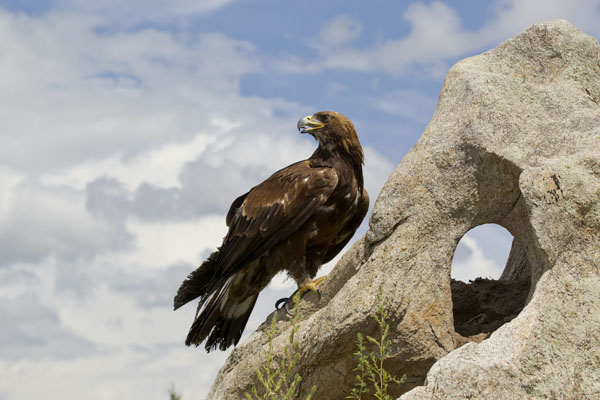Aquila chrysaetos
IUCN
LCBasic Information
Scientific classification
- name:Aquila chrysaetos
- Scientific Name:Golden eagle, old eagle, white eagle
- Outline:Raptor
- Family:Accipitriformes Accipitridae Aquila
Vital signs
- length:76-102cm
- Weight:2-6.5kg
- lifetime:25-70 year
Feature
Noted for its striking appearance and powerful flight
Distribution and Habitat
It mainly inhabits alpine forests and mountainous areas below 4,000 meters above sea level, and wanders to shallow mountains and hilly areas in winter. It usually moves alone or in pairs, and sometimes in small groups. It nests in high places, such as the tops of tall trees and on the leeward protruding rocks of cliffs. Some individuals, especially immature birds, migrate south in winter. It is the most powerful raptor in the Northern Hemisphere, and has a long-standing reputation. Its powerful hunting ability has made it the supreme eagle species in falconry activities since ancient times, and it has been constantly captured and sold. In nature, this species mainly feeds on medium to large mammals and large birds. The prey list usually includes geese, ducks, pheasants, squirrels, roe deer, deer, goats, blue sheep, foxes, marmots, hares, etc. Research on the diet of golden eagles in Mongolia shows that animals including great buzzards, demoiselle cranes, houbara bustards, eagle owls, w
Appearance
Male and female golden eagles are the same color. When they are young, their heads and necks are yellow-brown; except for the three outermost feathers, the bases of the two wings are all decorated with white, and the rest of the body is dark brown; the tail feathers are grayish white with black tips; in adults, there is no white on the wings and tail, and the feathers on the top of the head and the occipital area turn golden brown. Its tarsus is completely covered with feathers.
Details
The global population of golden eagles is estimated at around 300,000 individuals, equivalent to 200,000 mature adults. The European population is estimated at 9,300-12,300 pairs, equivalent to 18,500-24,500 mature individuals. Europe accounts for about 16% of the global population, so a preliminary estimate of the global population size is 116,00-153,000 mature individuals, although further verification is required. Precautionarily, the species population is placed at 100,000-200,000 adults.

Trend analysis: The species has been stable in North America over the past 40 years. In Europe, the species population size is estimated to be increasing, but given that the European population accounts for a small proportion of the global total, the overall trend is considered stable.
The golden eagle is a large bird of prey. It is 76--102 cm long, with a wingspan of 2.3 meters and a weight of 2--6.5 kg. The top of the head is dark brown, and the feathers from the back of the head to the back of the neck are long and pointed, in the shape of a willow leaf. The base of the feathers is dark reddish brown, and the feather tips are golden yellow, with dark brown feather stems. The upper body is dark brown, lighter on the shoulders, and the back shoulders are slightly decorated with purple luster; the upper tail coverts are light brown, with the tip close to black brown, the tail feathers are grayish brown, with irregular dark grayish brown horizontal stripes or patterns, and a wide black brown terminal spot; the upper wing coverts are dark reddish brown, with lighter feather tips, which are light reddish brown, the primary flight feathers are dark brown, and the base of the inner primary flight feathers is grayish white, with messy black brown horizontal stripes or patterns; the secondary flight feathers are dark brown, with grayish white markings at the base, and the ear feathers are dark brown. The chin, throat and front neck of the lower body are dark brown, with white feather bases; the chest and abdomen are also dark brown, with lighter feather shaft patterns, the leg coverts, undertail coverts, underwing coverts and axillary feathers are all dark brown, and the leg coverts have red vertical stripes. Juveniles are roughly similar to adults, but their body color is darker. In the first year, the tail feathers of juveniles are white with wide black end spots, the base of the inner vanes of the flight feathers is white, and white spots form under the wings; after the second year, the white tail and white spots under the wings gradually decrease, and the undertail coverts also change from brown to reddish brown to dark reddish brown. The iris is chestnut brown, the tip of the beak is black, the base is blue-brown or blue-gray (the beak of the juvenile is lead gray, and the beak is yellow), the wax film and toes are yellow, and the claws are black.








